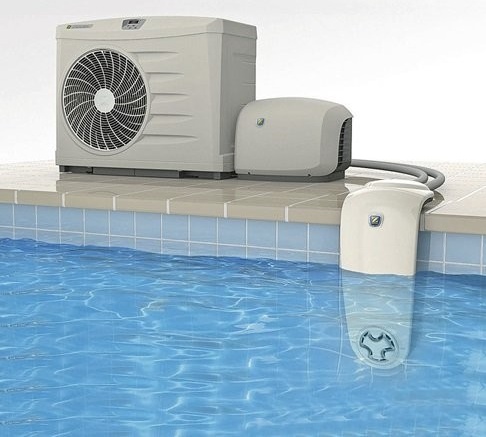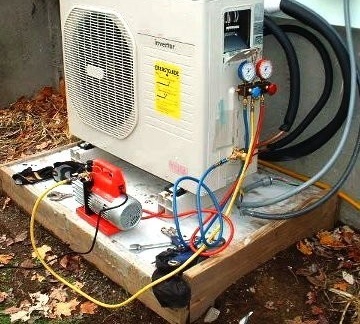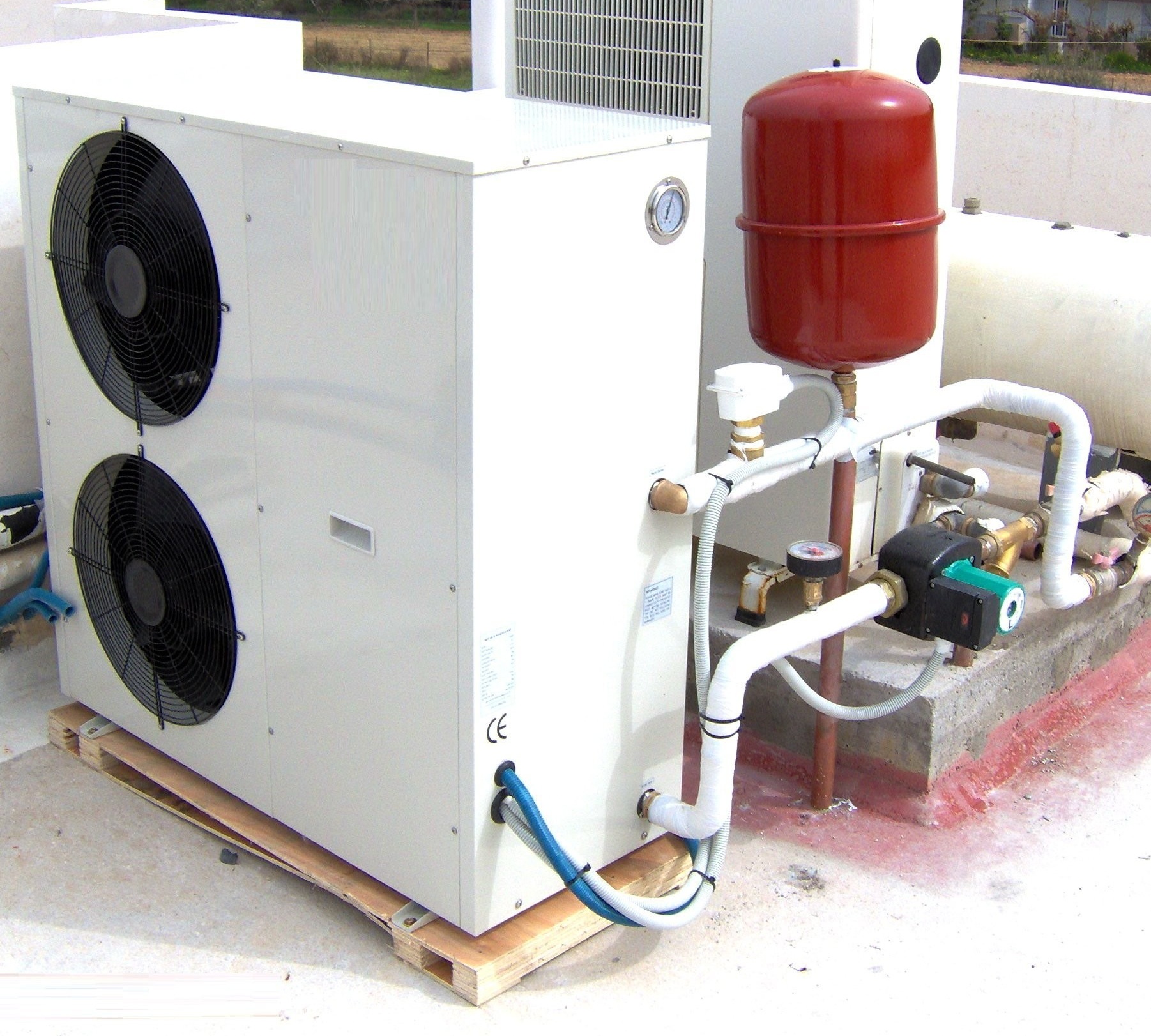Technology for assembling a heat pump of the water-water type with heat extraction from the well
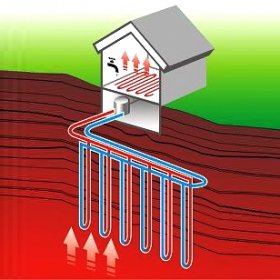
If it is impossible or too expensive to heat a private house with gas, and using solid fuel is not convenient, why not extract energy directly from the environment? One of the most effective options to get the necessary joules is a water-to-water heat pump. In the West, the industrial production of such units has long been established and is in high demand. However, their cost is quite high. Therefore, the question of creating a heat pump with your own hands remains very relevant.
Content
How is such a heat pump arranged and working?
Roughly speaking, a heat pump works like a refrigerator, just the opposite. The refrigerator removes part of the heat out to lower the temperature inside the chamber. Therefore, the rear wall of the refrigerator heats up noticeably. The heat pump “cools” the environment, heating the coolant that circulates in the home heating system.
Typically, water-to-water heat pumps consist of the following set of devices:
- external circuit;
- internal contour;
- evaporator;
- capacitor;
- compressor.
The outer circuit is a pipe through which groundwater circulates. It enters the system from the well, passes through the external circuit, giving the system thermal energy with low potential, and then is discharged into another well. Sometimes inside an external circuit immersed in water, there is a special fluid called “brine”. This is also a very effective way to collect the heat in the environment.
Note! If there is an open pond near the house, it can also be used as a heat source. However, there is no need to drill wells for the abstraction and discharge of groundwater.
Groundwater heat enters the evaporator. The pressurized refrigerant enters here through the capillary hole. The decrease in pressure causes an evaporation process and heat from the inner walls of the evaporator is transferred to the refrigerant. Gaseous refrigerant enters the compressor, where it is compressed, after which it is sent to the condenser.
Here, the refrigerant again turns into a liquid state, and the resulting energy is used to heat the coolant that circulates in the pipes of the heating system of the house. Thus, low-potential thermal energy of water is converted into energy with high potential and even in severe frosts it is possible to heat a house quite efficiently. This process is clearly illustrated in the diagram of the heat pump water-water.
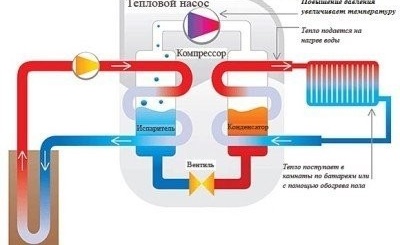
The water-water heat pump diagram shows the process of obtaining from the environment thermal energy with a low potential into high potential energy for heating a house and heating water
The quality of the heat pump is largely dependent on fluctuations in water temperature. The more stable the temperature, the better the heating. In the well, the water temperature throughout the year ranges from 7-12 degrees, which makes it possible to use the equipment very efficiently. To automate the operation of the device, they use a temperature controller that turns the compressor on and off, maintaining the temperature in the rooms at a certain level.
How to make such a device yourself?
A home-made water-to-water heat pump is a set of ready-made units that must be connected in the correct sequence. It looks simple, but in practice the whole thing can be ruined due to the lack of competent calculations. They are necessary to find out the optimal compressor power, the diameter of the heat exchanger pipe, as well as other system parameters. Non-specialists have several options for solving this problem:
- use special software (for example, CoolPack 1.46 and Copeland);
- use online calculators that are offered on the websites of manufacturers of such equipment;
- invite a specialist who will help to calculate everything for a fee or kindly sincerely.
So, now about each detail in more detail.
Part # 1 - compressor
The easiest way to get a suitable compressor is to remove it from the air conditioner, for example, from an LG split system. The seven-watt compressor has a capacity of 9.7 kW for heat production and 7.5 kW for cooling. An additional advantage of such compressors is the low noise level during operation.
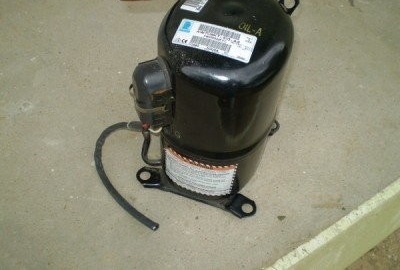
The compressor for the water-to-water heat pump can be removed from the old air conditioner. It is preferable to choose a model that is suitable for power and works silently
Many compressors use R22 freon, whose boiling point is -10, condensation - +55. In 2030, this refrigerant will be banned for use. A more suitable alternative could be the more “young” freon R422. However, it is possible to change the refrigerant not only when creating a heat pump, but also at any suitable time.
Part # 2 - Capacitor
A stainless steel tank of approximately 120 liters can be used to make the capacitor. It is cut in half, a copper coil is mounted inside, welded joints with a two-inch thread, then the halves of the tank are connected by welding. The area of the coil through which the refrigerant will circulate is calculated by the formula:
PZ = MT / 0.8RT, where:
- PZ - the area of the coil;
- MT - Power of heat generated by the system, kW;
- 0.8 - coefficient of thermal conductivity in the interaction of water and copper;
- RT - the difference in water temperature at the entrance to the system and at the exit from it, degrees Celsius.
For the manufacture of a coil, a half-inch copper pipe, a special refrigeration or clean plumbing, is suitable. The recommended pipe wall thickness is 1-1.2 mm. To turn a length of pipe of the desired length into a coil, it is enough to wind it on any suitable cylinder, for example, on a gas cylinder. The ends of the coil are brought out using plumbing adapters. To ensure the tightness of the connection, use flax and a clamping nut.
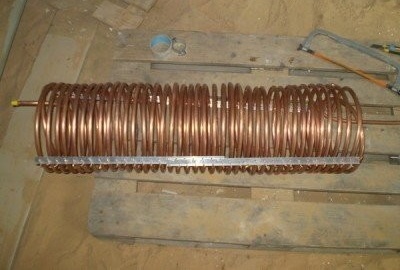
To make a coil for a water-to-water heat pump condenser, you need to carefully wind the copper pipe onto the cylinder. A metal rail will help to fix the pitch of the turns
Please note that the inlet of the freon line must be located at the top of the capacitor to prevent the formation of bubbles.
Item # 3 - Evaporator
A plastic barrel of 127 liters is suitable for the role of the evaporator. It is more convenient if she has a wide neck.The evaporator is calculated as well as the condenser. A copper pipe can be twisted with copper wire, without any insulation.

A home-made evaporator for a water-to-water heat pump can be made from a plastic barrel with a wide neck. The coil can be laid in a smaller capacity, but it’s more convenient to work with a barrel of more than 120 l
Experts recommend the use of "flooded" type evaporators for improvised heat pumps, in which the liquefied refrigerant enters the water from below and evaporates at the top. Adapters can be made from the necks of ordinary plastic bottles, which are fixed with flax and sealant. Standard sewer pipes are suitable for supplying and discharging water. When installing a thermostatic valve, before starting to solder the pipes of the leveling line, wrap it with a damp cloth, since this element cannot be heated to more than 100 degrees.
Freon assembly and refueling
To assemble the prepared devices into a single system, you will need a welding machine. At the compressor inlet, a filling valve is recommended, which will come in handy later on. Then, using a special vacuum pump, the system should be checked for vacuum.
To fill the system with freon, you will need a cylinder containing at least 2 kg of refrigerant. After refueling, it is recommended to wait a few days, checking the pressure in the system. If it remains constant, then there are no leaks. If the pressure decreases, you can determine the places of leaks in the simplest way: using soap suds. Inexperienced craftsmen are better off contacting a craftsman who will refuel equipment professionally and reliably.
For automatic control of the system, it is recommended to use a 40A single-phase relay, 16A fuse, electrical panel and DIN rail. Two capillary temperature sensors will be needed: at the exit from the system (the recommended maximum temperature is 40 degrees) and at the exit from the evaporator (shutdown temperature is 0 degrees to prevent the system from freezing). If a controller is used to take into account the readings of both temperature sensors, it should be remembered that its settings may go wrong during a power outage.
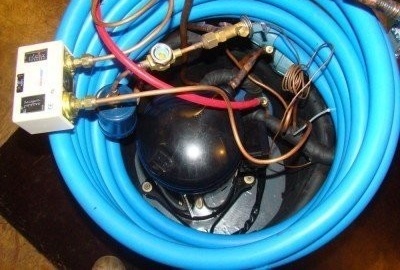
Something like this looks like one of the options for a homemade water-water heat pump. The device is covered by a metal housing on top of which the control panel is mounted.
After the system is ready, and its elements are placed in convenient places, two separate wells should be built for the intake and discharge of groundwater and bring the external circuit to the system. In areas where well drilling is associated with certain problems, this issue should be addressed first. If the wells cannot be drilled, you may have to choose another option for the heat pump, for example, ground-water.
The following video demonstrates the operation of a homemade heat pump:
Some helpful suggestions
Before proceeding with the manufacture of a heat pump, it is necessary to evaluate the level of thermal insulation of the building and increase it to the maximum level. Otherwise, the effectiveness of this system will tend to zero.
It is best to use a heat pump complete with low-temperature heating systems. Most often, the unit is connected to the "warm floor". Experience with systems of warm walls, large radiators, etc. can be successful. The efficiency of the system will be the higher, the smaller the difference in temperature on the external and internal circuits.
To reduce the cost of building a heat pump, it is recommended to use an additional heat source: gas, electric or solid fuel boiler. The required capacity and expenses for the construction of the heat pump will be less, and the cost of heating the home will be reduced.
